| Author | Message | ||
Highscore |
Has anybody done testing with different stacks yet? 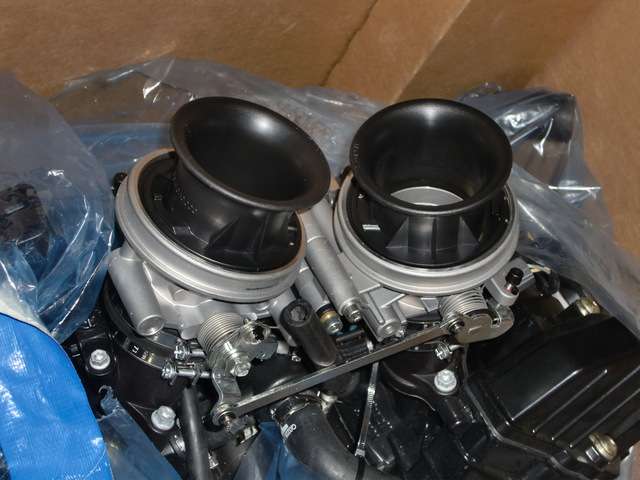 | ||
Redscuell |
Mate! I built my own, a bit taller @ 4" than those; but I didn't know there WERE any aftermarket ones like the ones in your pic. Where would I get 'em if I wanted 'em? How 'bout you; have you tested these? | ||
Vtwinbuell |
How about a explanation on the pic? Are those yours? There are numbers on the stacks, that makes me assume they are a manufactured piece and not one offs. | ||
Ccryder |
High score is in Austria, go figure. | ||
Ridenusa4l |
Highscore, WHERE DO I GET SOME OF THOSE!!! Me want alot!! Thanx Jake | ||
Peter_nikols |
Hi guys, I did a lot of fooling around with the velocity stacks on my V-Rod. I tested three different sets and ended up modifying the original set for the final iteration. What I found was that the taller stacks gave a bit more torque at low/mid range rpm at the expense of high end horsepower. I also tried very short aluminum stacks with small individual air filters. Those produced the most high end horsepower but lacked power at the bottom end. In each case I had to play with the EFI mapping to get any benefits. The same rules must apply with 1125 engine except for one thing - the Ram air effect. This changes things because it affects the intake pressure and requires a very specific match with the velocity stacks causing harmonic resonance. This means the stacks are tuned with the air scoops. Buell has been fooling around with this concept for many years. They used to call it the Hemholtz Volume Power System (HVPS). They use a much refined version of this Hemholts theory nowadays. So that means if you change the stacks, the torque might improve a bit on the low end but you may loose a whole lot of power on the top end because of the lost ram air effect. Having done many mods before, I can say this. No bike is perfect and engineers tend to compromise to get a balance between performance, reliability and emission standards. Therefore there is always something you can do to get a bit more of what you want, be it top end, bottom end, whatever... Just be prepared to make many more changes once you start. Frankly I don't think it's wise to change the stacks on the 1125. The only thing I will change is the air filter for a K&N and that's it! I'm still playing around trying to tune my V-Rod perfectly. Good Luck Peter | ||
Boodlum_the_hoodlum |
Intake stack length can be tuned like exhaust header tube length. Same principle applies. There's a reversion wave in the intake too that can be used to tune for power at a calculable rpm. An interesting sight is a BBC on the dyno with a fog of fuel hanging over the injector tubes. Fuel mixture gets pushed back out the intake by the reversion wave. Longer stack length tunes for lower rpm torque. Bood | ||
Highscore |
The stack, shown at the pic, is from a KTM Superduke 990. It has a length of 44mm. Tests with different velocity stacks are the next point on my "to-do-list" for dyno-testing the Helicon engine. Unfortunately my private 1125 is not on my side actually, it waits for "new cloths". Therefore I have to wait until February to continue my research. So the idea was born in me to ask this international auditory, if there are some experiences regarding this matter, I do not want to invent the wheel twice. What is my intention): The length of the intake runner up to the valves "programs" effectively the torque characteristic of an engine. This length determines, which wave, amplitude and frequency "fits" into a runner to create healthy, charge-improving resonances here. The stimulus for this wave action inside of the runner is the pumping action by the piston and the unsteady gas flow thereby. So there is always a relation between engine speed and resonance pattern of this wave: For tuning the "intake ram" to higher engine speed it is necessary to tune the wave action to a higher frequency and vice versa. A longer intake runner tunes for "low" a shorter for "high end". O.k. this is common knowledge, now the - probably - weird stuff: There is more than one solution for tuning an intake runner for - say - 100 hz We can match said 100 hz by making a runner for the fundamental of this harmonic. This would mean an intake runner of an considerable length of around 1,20m, wherein a wave of this frequency with just two nodes, one at each end of the runner, fits. Or we choose a harmonic a of higher order to match the desired frequency or rpm-range, this is an overtone of the fundamental. This "overtone" finds its space for wave propagation even within a shorter intake runner. Looking at intake runners of motorcycles, these are all rather short. It is common practice to choose an overtone of the 4th up to 6th order for"intake ram"-tuning of bikes. As shorter the intake runner is as higher is the order of this overtone. As higher this order, as less energy is transported within the wave and thereby transferred to the intake charge. On the other hand a high order "intake ram" occurs not only at one single point of the engine range like the tune for the fundamental wave with the very long runner. As higher the order of this overtone, as more "ram-peak-points" we may aspect with the engine´s power band. A "high-order-tune" is therefore a perfect tool to spread the power over the range, but for the price of engine efficiency, which means here torque. Still anybody with me? Let us come back to topics: our preferred toy - the Helicon engine. Here we find very short intake runners, shorter as any of its competitors, ´with enormous 61 mm throttle diameters, only the strongest Superbike Ducs match. I did not have calculated the order-# of the Helicone intake tune yet, because I do not know the cam timing yet - another point on my "to-do-list", but my strong believe is, that this number could be a record for stock bikes. Therefore my plan for a new intake ram tune for the 1125 is simple and straight forward: Let us install a runner length to this engine, similar to that of its competitor, by making the velocity stacks longer. When enlarging the runner length, by installing the proper stacks above, beyond a critical margin, this causes not only a change of said harmonic order, it also creates an all but new shape of wave pattern inside of the runner and thereby an all new torque characteristic of the engine. With such a new stack, the game of "fine-tuning" starts new from the beginning. Although the stack of such a "low-order-harmanic" intake-tune is definitely longer than the stock 1125 one, it should be nevertheless possible to fine-tune it within its new harmonic order for peak power at high rpm by altering its lenght carefully, If things run as aspected, the gain for this effort should be an additional ton of torque in the middle of the range without any losses at the upper end of the range. For this reason experiences from a Harley-V-Rod may not be applied directly to the Helicon engine. The Helicon is not the first engine I have designed new velocity stack for: [URL=http://img216.imageshack.us/i/trichterserie.jpg/][IMG]http://img216.imageshack.us/img216/300/trichterserie.th.jpg[/IMG][/URL] [URL=http://img142.imageshack.us/i/trichter.jpg/][IMG]http://img142.imageshack.us/img142/7415/trichter.th.jpg[/IMG][/URL] This stacks are designated for the 1050 Triumph triple and "good" for 5% of additional torque over the whole range without any other mod like fueling. It is a matter of try and error - at the very end - which stacks are the best for the 1125. Some guys have performed thousands of dyno runs on this engine. So may be the perfect design for this stacks is known yet. I hope this is no secret know how. If I know new facts by my own research, I keep you informed. Highscore (Message edited by Highscore on January 07, 2010) (Message edited by Highscore on January 07, 2010) | ||
Boodlum_the_hoodlum |
Score, don't ignore using two different stack lengths to spread the torque curve over a wider rpm band. Takes a little off the max torque at a given rpm but can make the torque curve more usable (ie. a less peaky curve). Engine looks less powerful on paper but drives quicker on the track. Bood | ||
Nm5150 |
Score, Good info.If you really want to get trick,don't some bikes have stacks that change in length?Best of both worlds? Cavedug | ||
Ccryder |
At least Yamaha and proably others have some sort of variable length intake stacks and runners. | ||
Sknight |
Good info, I may have to hit up my KTM dealer. I've always knew how to tune for torque or horsepower but your explanation made it very clear how it works. | ||
Highscore |
I have chosen these KTM stacks, because I have them by hand are here. Therefore nobody should aspect that these stacks are a 1:1 swap. For a fast test on the dyno I would just lay these KTM-stacks onto the stacks of the stock 1125 throttle bodies and ask someone, standing around in the workshop to hold them in place there during the dyno run. A simple series of test runs should be enough to give a clear picture of the influence of these stacks on engine torque and performance: (1) A check run in "all stock" (in my case for "the-last-known-combination). (2) A new run without cover, airbox lid and filter, displaying the stock throttle throats to the atmosphere around (you should recognize that difference in performance just little compared to the stock air box). (3) Then put the KTM-stacks onto the stock stacks, secure them provisorily and make a run on the dyno. I shall perform this test as soon as my 1125 is back again. The KTM stack has just an internal diameter of 58mm. Nevertheless this test could be really informative, because I have the strong believe that the 61mm butterflies of the stock 1125 throttle bodies are to large for the rev range and limit of the stock Helicon engine: 61mm is perfect,when you are looking for peak power at 12.000. My goal for a new and better engine set up for the stock Helicon engine with its limiter at 10.500 is to boost its power and torque in the mid range, side by side with good rideability by a perfect response. For this purpose a shy reduction of the intake diameter could be even advantageous. Everybody - especially the dyno owner - is invited to do this test. But please keep us informed about the result. Highscore | ||
Peter_nikols |
Hey Highscore, I've read all that stuff before. Thanks for the explanation anyway, but I tried to keep it in simpler terms. I agree with what you said for the most part. I believe we all agreed that taller stacks help to tune an engine for low/mid range torque. I'm not sure at all about these multiple peaks you refer to. So I won't argue... However you are missing the point that I think is most valid here. The 1125 is a very well tuned engine without much room for improvement as it stands. The Induction and Exhaust systems are both tuned to benefit the engine in the same power range. The Ram Air is also tuned in and is a considerable benefit that is possible compromised by fooling around with the stacks. So if you change the stacks you should change the exhaust as well and then re-map the EFI. The effect of the Ram cannot be measured or tuned in during a DYNO run so good luck tuning it properly... And despite the obvious differences between a V-Rod Engine and a Helicon Engine which is a much more finely tuned machine, the two engines have considerable similarities. For your info: V-Rod Engine: Porsche Designed Engine Type: 60 degree V2 Displacement 1130cc Max Torque: 80ft.lbs @ 7000rpm Max Horsepower 120hp Bore & stroke: 100mm x 72mm Compression: 11.3:1 EFI System: Sequential Port Fuel Injection Valvetrain: DOHC - chain driven Cooling: Liquid Cooled Lubrication: Dry-sump with integrated oil reservoir in lower crankcase Air Induction: Staggered length Velocity stacks in a pressure sealed air box with single throat ram. Fuel Delivery: Dual 53mm down draft throttle bodies Exhaust: 2-into-1-into-2 (3 section) with staggered length head pipes Helicon Engine: Rotax Designed and Built Engine Type: 72 degree V2 Displacement 1125cc Max Torque: 82 ft.lbs @ 8000rpm Max Horsepower: 146Hp + 5 from Ram Air effect Bore & Stroke: 103mm x 67.5mm Compression: 12.3:1 EFI: DDFI III Fuel Injection Valvetrain: DOHC - gear driven Cooling: Liquid Cooled Lubrication: Dry-sump with integrated oil reservoir in lower crankcase Air Induction: Equal length Velocity stacks in a pressure sealed air box with ram air. Fuel Delivery: Dual 61mm down draft throttle bodies Exhaust: Helmholtz tuned resonance chamber (single) with equal length head pipes In conclusion, when I messed around with the stacks on the V-Rod I gained 1 or 2 horses in the mid range and lost a few off the top. On the Helicon you'll probably gain 1hp in the mid and loose at least 5 off the top. Have fun in either case..... Peter | ||
Redscuell |
As mentioned I have 100mm/4" tall velocity stacks on mine. And I really only installed them because the huge void left in the intake plenum (the area under the air filter) shouted out for them. And tho I have had them in and out, there is no evidence so far from the many dyno runs that they move the torque curve materially, or even affect the fuel curves; that is, that one could notice on the map or feel in the s-o-t-p meter. MAYBE when it goes on the dyno again, to compare the stock muffler with my own custom muffler, I will go to the expense (costs me ~A$100 per run) of testing with and without the oem 'intake funnels' and my custom stax. If so, I will post up. | ||
Responsible |
We had stacks made up for our bikes, mostly to use in the Thunder Class (HP limited) They worked pretty well and we passed on a couple of sets to the factory, who made some for the MOTOST bikes. Hopefully the still have the drawings/CAM files, and they'll be in the EBR catalog. Pete | ||
Highscore |
Rotax just delivers an engine, the final set up, air box and exhaust design, throttle bodies and FI-system are the job of the customer. That is the way for Aprilia,´BMW abd Buell too. I have serious doubts that this Buell is perfect, because of this engine:  This engine belongs to a KTM Superduke "R" and has just 990ccm displacement by 101mm bore and 62,4mm stroke, throttle 52 mm diameter. But nevertheless this engine cranks out this torque:  This engine is more than 10% smaller as the Helicon engine. So its torque gives the solid proof, that the KTM charges substantially better than the Buell. This problem I would like to understand to find the proper key to solve it. Highscore (Message edited by Highscore on January 11, 2010) | ||
Redscuell |
Highscore, I asked that very question of one of the local m/b mags (mainly, how is this possible with relatively smaller bores). The editor attributed it to a different design philosophy of cylinder filling, which really didn't help me understand any better! | ||
Blower1 |
It would be interesting to know if the stacks help to get more torque. It´s the mid range torque, which makes most fun to the street riding. I made a two sets of velocity stacks with nylon holders. Stacks are 2" and 2 3/4" long. I´m going to test them, when this bloody winter is ower. 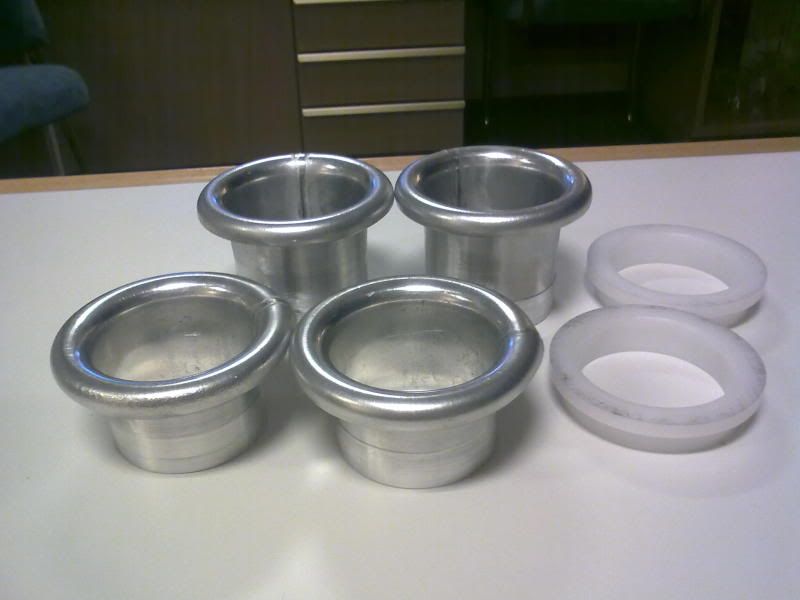 | ||
Blower1 |
Found one intake runner length calculator (by Bowling & Grippo) and it shows the following things: 10" runner length (1125 original length from valve to the stack end) ; 2nd harmonic pulse rpm range is from 11748 to 14256. ; 3rd harmonic from 8827 to 10088. ; 4th harmonic from 6882 to 7696. The 2nd pulse, which is the strongest is over the operating range. If making runner length to 12" are results following: ; 2nd harmonic from 9790 to 11880. ; 3rd harmonic from 7356 to 8407. ; 4th harmonic from 5735 to 6413. If these calculation results work in the real world, it´s possible to make more top end power and mid & low end torque with 2" longer velocity stacks than original ones. I test the fitment of my "home made" 2 3/4" long stacks. They fits well under the air filter. 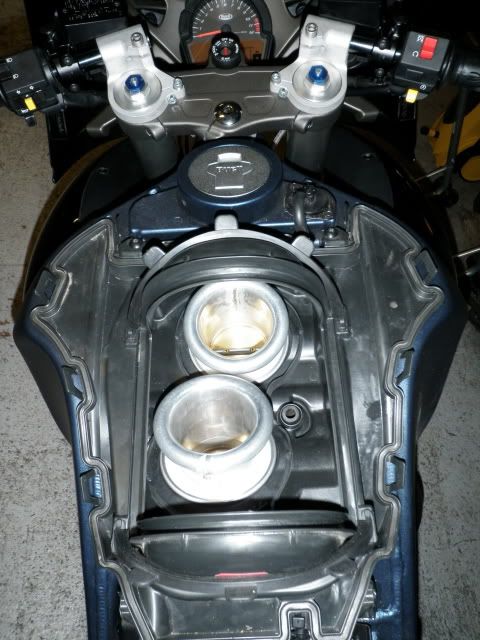 | ||
Blackflash |
Looks good blower!! | ||
Redscuell |
After last week making a baseline with the stock intake, exhaust, and mapping; today the bike was dynoed with all the intake mods reinstalled, but still with stock muffler and mapping. The intake mods include 4" tall velocity stacks, denoided & tied, k&n, cold-air intake through intake cover and airbox. Result: hp up 5, tq up 5 ft/lb in the 4,000 rpm to 10,000 rpm range; with tq actually down @ 10,000 rpm (but hp up there). Don't have the resources to test each intake mod separately; so who knows just how much of that was due to intake stacks. I'm happy with an overall increase in the useable rpm range, though. Will post up pics and maps, perhaps today. In a few weeks the third prototype '3rd Pipe' muffler will go on, and be dynoed with and without fuel remapping. For the record, the baseline was done with the latest oem flash, and fueling is very good in the 12-13 range. With the intake mods the fueling leaned out by 1 (13-14 range). | ||
T_man |
Hey Red concerning: 'cold-air intake through intake cover and airbox.' Are you talking about an aftermarket modification you've done (as in punching an intake through the airbox) or does the cold air intake simply refer to the stock set-up? Thanks for posting the useful info thus far. | ||
Thefleshrocket |
Result: hp up 5, tq up 5 ft/lb in the 4,000 rpm to 10,000 rpm range; with tq actually down @ 10,000 rpm (but hp up there). This doesn't make sense. Horsepower is a function of torque and RPM. If torque is down at a given RPM, horsepower will also be down. It's mathematically impossible to lose torque at a given RPM but gain horsepower.} | ||
Redscuell |
My stax are white because my bike is white: 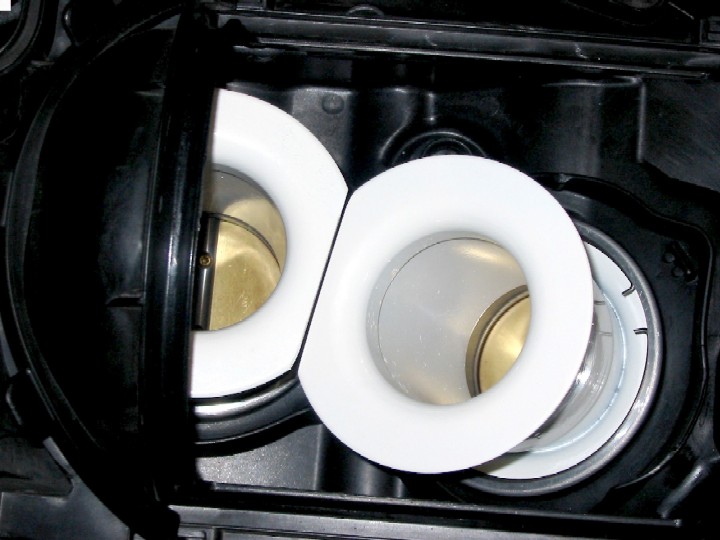 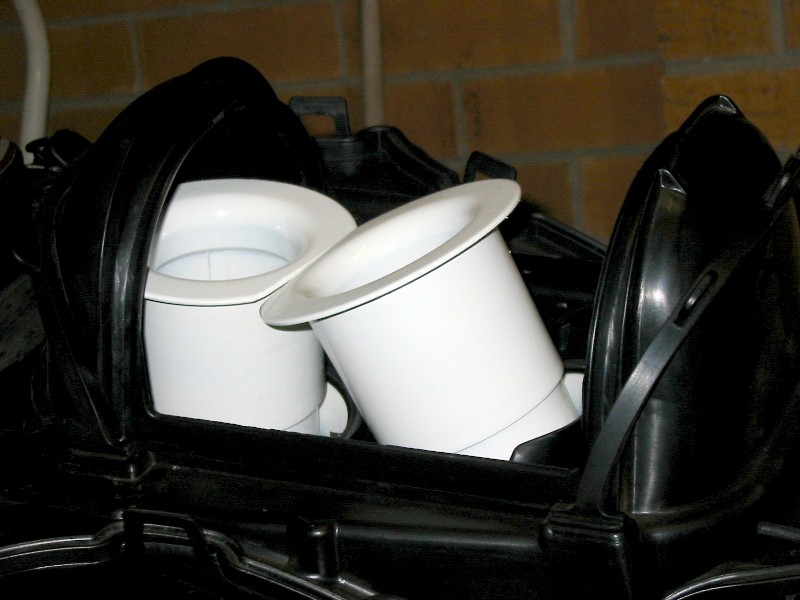 They are 4" / 100 mm tall because my objective was to fill the plenum. They are full bore diameter at the bottom (exit to throttle bodies) but smaller at the intake bell; just because that's how my available bits worked out! If I were to have blower's bits available, and expecting that they're full internal diameter of the existing throttle bores, then I'd likely want to extend them to the max. 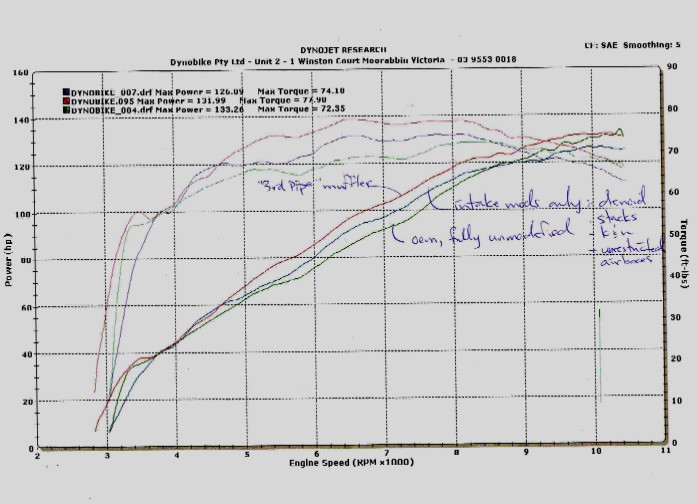 The lowest (green) line is the baseline, with NO intake or exhaust mods, and has the stock map. The middle line (blue) is with the intake mods only, as listed above. This is with the oem, latest flash and as mentioned above, the fuel has leaned out by a factor of '1'; which may explain the falling off of hp at the highest revs. The highest line (red) is with the intake mods, and with the modified prototype #2 muffler with matching fuel map. You'll see that torque is up in the midrange (around 6500 rpm) by ~5 ft/lbs, with just the intake mods; and with proto #2 muffler, is up nearly 10 ft/lbs at the same point. Also note that hp is up 5 (intake mods only) and 10 (intake mods plus muffler and fuel map) across a range of 5,000 rpm to 9,000 rpm. This is all usable hp and tq increases. Oh, and sound is 'v-twin' but not 'loud'; dB(A) still 94. In a few weeks' time the final (for me) muffler (proto #3) and matching map will go on. All three of the mufflers I've done have assumed that Buell's muffler is worth retaining as long as the restrictions at both ends (in and out) are removed. Will check noise with the DB meter at that time, too. (Message edited by redscuell on January 19, 2010) (Message edited by redscuell on January 19, 2010) (Message edited by redscuell on January 19, 2010) | ||
Redscuell |
"The KTM stack has just an internal diameter of 58mm. Nevertheless this test could be really informative, because I have the strong believe that the 61mm butterflies of the stock 1125 throttle bodies are [too] large for the rev range and limit of the stock Helicon engine" I made this same assertion at the beginning ot my time on Badweb, and copped a lot of flack for it. My feeling was based on the sizes of the ktm and ducati bores vs. ours on the buell. "For this purpose a shy reduction of the intake diameter could be even advantageous. " Interesting; mine are smaller only at the intake bore, for about 15-20 mm depth; I'm recalling about 56-58 mm i.d. Then full bore of 60 mm for the balance until they meet up with the throttle bodies. And I've achieved a healthy, worthwhile torque increase and movement into the midrange (peak torque has increased 10 ft/lb and is now at 6500 rpm vs 8000 rpm). | ||
Blower1 |
Redscuell; If you look at your dyno chart baseline torque curve and my calculated results, you can see where the third and fourth harmonic pulse hits. If using 2" longer stacks than originals, the second and strongest pulse should come to the max power range. The third pulse would then come to the max torque range and the fourth between 5700 and 6400 rpm. | ||
Redscuell |
Thanks, blower; but I've no idea what you're trying to tell me. Is there something there, that tells me my stacks are on or off the money? | ||
Bads1 |
There was plenty of testing on this on this forum. It was done back in 03 and 04. There was zero improvement over stock. | ||
Redscuell |
"There was plenty of testing on this on this forum. It was done back in 03 and 04. There was zero improvement over stock." Which would've been on an XB? Certainly not on a commercially-available 1125. Are you then trying to say that 100% of the torque and power improvement shown in my map, came from the other three changes: denoid (no evidence in this forum), improved airboxes (air velocity in this dyno room does not exceed 60 kph, so Buell's claimed 'supercharging' effect isn't operational) -- which would leave the k&n, which also somehow moved the peak torque point, too? |